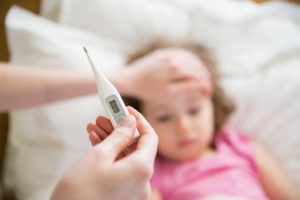As a new mother, you can encounter a number of childhood illnesses. Some cause sleepless nights, while others are completely harmless. In the child, ringworm is considered harmless. However, serious consequences can arise for the unborn child.
Learn everything you should know about ringworm in children.
Table of contents
Ringworm: A Highly Contagious Viral Infection
Ringworm is a contagious disease caused by parvovirus B19. Similar to well-known rubella, ringworm in children is one of the classic childhood diseases. Nevertheless, it should be mentioned that adults can also fall ill.
It is not uncommon for an infection with the pathogen to be silent, so that no signs of illness occur. Characteristic for an infection is a typical skin rash. In very rare cases, serious complications occur.
Compared to the normal rubella infection, there is no vaccination against ringworm in children. If an infection occurs, no cause-related therapy is possible in principle. Only symptoms that may occur can be alleviated.
Infection with parvovirus B19 during pregnancy can have serious consequences for the unborn child. If there are signs of pregnancy, persons with the disease should be avoided urgently.
Ringworm In The Past
Since 1905, ringworm in children has been called the fifth disease. Interesting in this context: doctors tried since the 17th century to distinguish and systematize the various childhood diseases that are accompanied by a rash.
These diseases include, for example, measles, rubella and scarlet fever. In 1900, Clement Dukes described a fourth disease. Nowadays, however, this is no longer considered an independent disease.
Subsequently, in 1905, doctors recognized ringworm and described it as a fifth disease. For a long time, however, the cause of this rash-causing disease was unknown. Parvovirus B19 was identified as the cause of the infection in 1983.
Ringworm Only Possible In Humans
In principle, ringworm infection is only possible in humans. Transmission occurs via droplet infection, during direct contact. Furthermore, infection is possible through contaminated hands and relatively rarely through infected blood products.
The disease is particularly contagious within the first four to ten days after infection with the pathogen. Ringworm in children is thus practically no longer contagious once the rash appears. It is believed that a single infection with the virus leads to lifelong immunity to it. This means that anyone who has already contracted ringworm cannot become infected again.
Although ringworm in children is a very contagious disease, the rate of infection is comparatively low. Among preschool children, an estimated five to ten percent have already been infected.
Among adults, 60 to 70 percent were already affected. If there are signs of pregnancy, it therefore makes sense to check one’s own immunity status with regard to parvovirus B19.
So far, however, there are no figures describing how frequently an infection occurs during pregnancy. It is certain, however, that an infection during pregnancy leads to illness of the unborn child in five to ten percent of cases. There is a high risk for the child between the 13th and 20th SSW.
Incubation Period For Ringworm In The Child
Particularly difficult: The incubation period, i.e. the time between infection and outbreak of the disease, is between four and 14 days. In rare cases, it can be up to three weeks. However, the viruses are excreted between the fifth and tenth day after infection, i.e. in most cases before the onset of the disease.
During virus excretion, there is a particularly high risk of external infection. Thus, the possibility of transmission is highest before the actual disease.
Symptoms Of Ringworm In Children
In most cases, an infection with ringworm runs its course without any signs of illness. Thus, the disease proceeds silently – immunization nevertheless takes place. In other cases, similar to normal rubella, there is a typical rash and flu-like symptoms.
It should be noted that the characteristic rash is observed in only 15 to 20 percent of all infected persons. This begins on the cheeks and is characterized by large, red spots. These increasingly merge.
The mouth area is mostly left out. This is also referred to as a butterfly rash. Within the following days, a rash similar to rubella also appears on the shoulders, upper arms, buttocks, and thighs.
This is characterized by spots that are slightly raised and merge. In the center, the spots pale. This often gives the patterns a garland-like appearance. These skin manifestations can be extremely changeable and last up to seven weeks. However, the general condition of the children is only slightly affected.
Possible Complications
In the past, various complications have been observed during infection with ringworm. Occasionally, for example, the joints become involved, and inflammation and pain of the small joints in particular are possible.
Girls and younger women are particularly affected. In most cases, the symptoms subside after about two weeks but may persist for several months. In principle, however, they stop on their own without special treatment.
Serious Consequences Of Ringworm
In addition, there are various complications related to red blood cells. Affected individuals suffering from chronic anemia may develop an aplastic crisis.
This can be so severe that even the bone marrow of the affected person temporarily stops producing red blood cells. Often such a crisis, which is triggered by ringworm, is the first significant sign of spherocytic anemia.
In affected individuals, the typical rash is usually always absent. If, on the other hand, infected persons suffer from an acquired defect of the immune system, virus eradication is usually disturbed. In this context, chronic recurrent anemias are possible. Usually, no antibodies against parvovirus B19 are detectable in the infected persons.
Ringworm During Pregnancy
It is well known that infection with rubella during pregnancy is highly dangerous for the unborn child. An infection with ringworm during pregnancy should also not be underestimated. This is particularly dangerous between the 13th and 20th weeks of pregnancy.
In about one-third of cases, the virus is transmitted to the unborn child via the placenta. In the child, ringworm particularly affects the cells responsible for red blood cells and destroys them. The blood-forming cells in the bone marrow and liver of the unborn child are particularly affected.
Potential Consequences Of Ringworm Infection During Pregnancy
As a result, a significant reduction in the number of efficient red blood cells occurs. Serious anemia results. Accompanying symptoms may include hydrops fetalis, a decrease in cardiac output, and ascites.
The named hydrops fetalis is a marked accumulation of fluid around large parts of the fetal body. This fluid accumulation may further occur in the serous cavities of the body, for example, in the pericardium.
Ascites, on the other hand, is a marked accumulation of serous fluid in the abdominal cavity of the unborn child. In this context, there is also talk of a water belly. Due to these accompanying symptoms, a miscarriage is possible in the worst case.
Statistically, this occurs in about nine percent of cases. The risk of this is particularly high in the case of infection with ringworm between the 10th and 22nd week of pregnancy.
Progress Controls During Pregnancy Are Indispensable
If a fetal infection occurs, regular progress checks via ultrasound are advisable. In the case of fetal anemia, blood transfusion via the umbilical cord is possible. If there are no complications during pregnancy, there are usually no long-term consequences for the child.
Currently, there are no indications that ringworm causes malformations or developmental disorders in the child during pregnancy. Parvovirus B19 is not an indication for a possible termination of pregnancy.
Recognizing Ringworm In The Child And Distinguishing It From Rubella
If a typical skin rash occurs during infection with ringworm in a child or adult, the disease can be recognized quite easily from a doctor’s point of view by the clinical picture. If, on the other hand, the case is unclear, acute infection can be detected by the virus-specific antibodies in the blood serum.
If there are signs of pregnancy, it is generally advisable to check the blood status in order to detect antibodies if necessary. Important: In persons with immunodeficiencies, the serological result may remain negative.
In this case, direct detection of the virus is required. If infection with parvovirus B19 occurs during pregnancy, the IgM antibodies in the fetal serum can usually still be detected after birth. Furthermore, detection during pregnancy from amniotic fluid or umbilical cord blood is possible.
Preventing Ringworm
As is known, there are vaccines against normal infection with rubella. However, this is not the case with ringworm. There is no evidence against the preventive effect of available immunoglobulins.
If infection with ringworm occurs in a child suffering from a chronic blood disorder, the child is in principle infectious for longer than other affected persons. Isolation is necessary to prevent further spread of the virus.
Due to the fact that ringworm viruses are extremely stable, regular disinfection of hands is necessary during an infection. In this way, infections can be contained and prevented, for example in hospitals.
Ringworm Treatment
To date, there is no specific therapy for ringworm in children. As with normal rubella, treatment is symptomatic. Immunoglobulins are used, especially in affected individuals with immunodeficiency, viral persistence, or anemia. Weekly ultrasound examinations are required during pregnancy.
FAQs About Ringworm In Children
No. 1. Is Ringworm The Same As Rubella?
Rubella is caused by the rubella virus. Ringworm in children is caused by parovovirus B19.
2. At What Age Can The Virus Appear In A Child?
Ringworm in children can occur at any age. Infection is also possible in adulthood. Approximately five to ten percent of all preschool children have already been infected. In adults, the rate is about 70 percent.
3. Who Can Transmit Ringworm Viruses?
The transmission of parovovirus B19 is only possible from person to person, via droplet infection. The probability of transmission is particularly high within the first four to ten days after infection.
4. How Often Can Ringworm Occur In Children?
After a single infection with the virus, the body forms antibodies so that no further illness is possible.
5. How Long Is Ringworm Contagious In Children?
The risk of transmission is particularly high during the first four to ten days after infection. After the appearance of the typical house rash, affected persons are no longer contagious in most cases.
6. How Long Does The Rash Last During An Infection?
The duration of the rash is individual. In most cases, it subsides on its own after about 14 days. In some cases, however, rashes can last up to seven weeks.
7. When Are Ringworm Infections Dangerous During Pregnancy?
There is a particular danger for the unborn child between the 10th and 22nd week of pregnancy.
8. How Long Should Children Stay At Home In The Event Of An Infection?
Since the risk of infection is mostly over once the infection is known, it is not necessary to stay at home permanently. In this context, however, medical consultation is recommended.











1 thought on “Ringworm In Children: Often Detected When It Is Too Late”